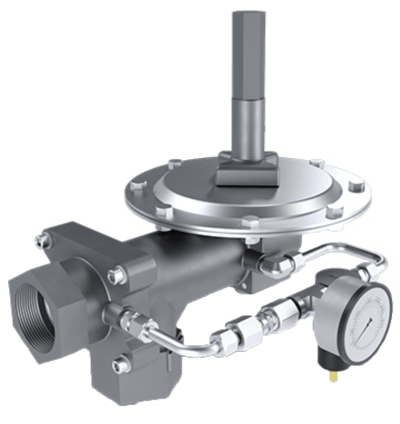Description
Tank Blanketing is an effective means of preventing fires in flammable liquid storage tanks by controlling the formation of explosive vapor / air mixtures.
Blanketing minimizes evaporation of the stored product, thus reducing emission levels and product loss.
Protection from external sources of contamination that may adversely affect the tank’s contents is also provided.
Features- 2" NPT inlet and outlet standard
- Pilot operated design provides tight operating band
- Optional inlet and outlet connections available
- Inlet gas pressures from 40 psiG to 130 psiG
- Set points from -0.5 in WC to 69.2 in WC
- Optional flow plates to meet specific flow requirements
- Fully field serviceable
- Optional pilot and sense line gauges
- System purge and field test capability available
- Conforms to the latest ATEX Directive
Specifications
Specifications
Brand
Approvals & Certifications
- ATEX
Characteristics
- Availability for Large Quantity Use
- Chemically Inactive
- Cost
- Non-Contaminating
- Non-Flammable in the Atmosphere being Protected
- Non-Toxic
Considerations
- Contamination of the Inert Gas from Any Source Must be Guarded Against. Any Inerting System Should have Suitable Devices to Hold Moisture & Debris to an Absolute Min., Such as Filtration Systems.
- Inert Gas or Tank Blanketing Equipment Must be Completely Reliable & Capable of Maintaining an Adequate Supply of Inert Gas at All Times. Equipment Breakdown or Equipment that is Inadequately Sized for the Job Will Result in a Higher Oxygen Concentratio
- The Inert Gas Should be Introduced into the Tank in Such A Manner that It Can be Distributed Effectively.
Custom Fittings & Hardware
- Others
Diaphragm
- Fluorinated Ethylene Propylene (FEP) Film
Enclosure, Body Material
- 316 Stainless Steel
Features & Benefits
- A Comprehensive Range of Materials are Offered
- A Range of Flow Orifice Plates Provides the Opportunity to Tailor Flow Capacity to Individual Requirements
- Designed Specifically for Tank Blanketing
- Field Serviceable
- Most Compact Design & Fewest External Connections of Any Pilot-operated Valve on the Market
- Pilot-operated Design Provides Very Tight Operating Band
- Pressure Balanced Pilot Provides Consistent Opening Pressure over the Range of Possible Supply Pressures
- Protectoseal Pure-Tech High Purity Blanketing Valves are available for Applications Involving High Purity Products
Flange Size - 2” (DN 50)
- 2" (DN 50) - 150#
- 2" (DN 50) - 300#
- 2" (DN 50) - PN 10
- 2" (DN 50) - PN 16
Flange Size - 3” (DN 80)
- 3" (DN 80) - 300#
- 3" (DN 80) - PN 10
- 3" (DN 80) - PN 16
- 3" (DN 80) -150#
NPT Connection
- 2" NPT Female
- 3" NPT Female
Operating Characteristics
- The Set Pressure of the Protectoseal Series 10, Blanketing Valve is Specified as the Pressure at Which the Main Valve Opens. Generally, the Pilot Valve Will Begin to Leak at A Pressure Slightly Above the Set Point. as the Pressure Moves down to the Set Po
Options for Connections
- 150# or 300# Welded American National Standards Institute (ANSI) Flanges on Inlet or Outlet
- 150# or 300# Welded American National Standards Institute (ANSI) Flanges on Outlet Only
- Female National Pipe Thread (Female NPT) Inlet & Outlet
Options for Filter
- Acetal
- Acetal Stainless Steel
- Aluminum
- Buna-N
- Polypropylene
- Viton
- Zinc
Options for Flow Orifice Plates
- None (100 % of Max.
Other Options
- Field Test Accessories
- Integral Purge on Main &/or Sense Line (Protectoseal Recommends the Use of Purge when Tank Vapors Can Solidify or Crystalize when Cooled to Ambient Temperatures)
- Pressure Gauges on Pilot Inlet &/or Sense Line
- Single Port Sensing
- Status Port Option
- Supply Line Filter
- Swing Check Valve between Pilot Inlet & Main Supply Line
Principle
- A Blanket or Pad of Inert Gas in the Tank’s Vapor Space Prevents Atmospheric Air from Entering the Tank. the Inert Gas, Usually Nitrogen, is Injected, as Necessary, into the Vapor Space in Order to Maintain A Non-flammable Atmosphere. the Blanketing Press
- Although Nitrogen is Most Commonly used for Inerting, Other Gases, Including Natural Gas, May be used in Some Applications.
- The Amount of Inert Gas Required for a Specific Application is based on the Max.
- This Inert Gas is Admitted Only During Inbreathing Cycles (Vacuum Cycles). an Inbreathing Cycle Occurs when Liquid is being Withdrawn from a Tank, or when Vapors Condense in a Tank Due to A Decrease in Temperature.
Principle of Operation
- A Blanketing Valve is used in Tank Blanketing Applications to Regulate the Pressure of the Inert Gas Layer on Top of a Tank’s Stored Liquid. the Valve Senses the Pressure of the Tank Blanket & Opens to Flow in More Inert Gas when Pressure Drops Below Th
- A Small Fraction of an inch of Movement of the Poppet Vacates the Dome Volume by Allowing Flow Past the Two Seats & Out of the Pilot Exhaust (O). This Causes the Piston in the Main Valve to Open to Allow Gas Flow into the Tank. the Piston is Normally He
- The Protectoseal Series 10 Blanketing Valve Essentially Consists of Two Separate Valves Operating in Tandem. the Pilot Valve (A), which is Controlled by the Sensed Tank Pressure, in Turn Controls the Opening & Closing of the Main Valve (B) Which Provides
- The Sensed Pressure in the Pilot Valves Comes through A Remote Sensing Line (F) which is Connected to the Tank at A Distance Far Enough from the Blanketing Valve Connection that It Will Not be Affected by the Flow Stream of Inert Gas into the Tank. the Se
- Three External Connections are Required for Operation of the Blanketing Valve. One Line (F) Runs from the Tank into the Pilot Valve to Provide the Controlling Pressure. the second Line (G) Comes from the Inert Gas Supply & Connects to the Main Valve Inlet
- When Gas Flow into the Tank Raises Tank Pressure Above the Set Pressure, the Sense Diaphragm is Pushed Up Allowing the Stop & the Poppet to Raise Up (Due to the Spring Force Under the Poppet) Until the Poppet Reseals. when the Poppet Reseals, the Dome Pre
Single Port Sensing Option
- Efficient Control of Tank Pressure
- Eliminates Need for Separate Sense Line Connection to Tank
- If the Preferred Independent Sense Line Configuration cannot be Accommodated, the Single Port Design Allows for Mounting the Blanketing Valve with Only One Tank Connection. Tank Vapor Space Pressure Sensing & Blanketing Gas Supply are Accomplished Throu
- Single Connection Mounting
Springs
- 302 Stainless
Standard Fittings & Hardware
- 316 Stainless Steel
Standard Valve Bodies & Components
- 316 Stainless Steel
Status Port Option
- Allows Alarm when Blanketing Gas Flow is Excessive
- Offers Remote Monitoring Via Pressure Transmitter
- Please Contact the Protectoseal Factory for Assistance with Tank Blanketing Valve Selection & for Information on Protectoseal’s Full Range of Vapor Control Products.
- Provides Indication of Open vs. Closed Valve Status
- Reduces Operating Costs by Allowing Monitoring of Blanketing Gas Usage
- The Status Port Option for Protectoseal Series 10 Pilot-Operated Tank Blanketing Valves Consists of a 1/4" National Pipe Thread (NPT) Threaded Port Connection in the Valve Body. This Allows the Addition of a Pressure Transmitter (Provided by Other Source)
- The Tank’s Monitoring Instrumentation Would be Calibrated to Indicate an Alarm Condition if the Open Signal Continues Beyond A Predetermined Time Required for Tank Repressurization. Action Can Then be Taken to Address the Problem & Preclude the Loss of Bl
- When the Blanketing Valve is Closed, the Pressure in the Dome is the Same as the Supply Pressure. when the Valve is Open, the Pressure in the Dome Drops & is Significantly Lower Than the Supply Pressure.
Working
- The Conservation Vent (A) is Sized to Take Care of Overpressure & Vacuum Conditions Brought About by Unforeseen Conditions for Equipment Failures. the Pressure Setting of the Vent is Set at A Slightly Higher Setting Than the Blanketing Pressure in the Tan

